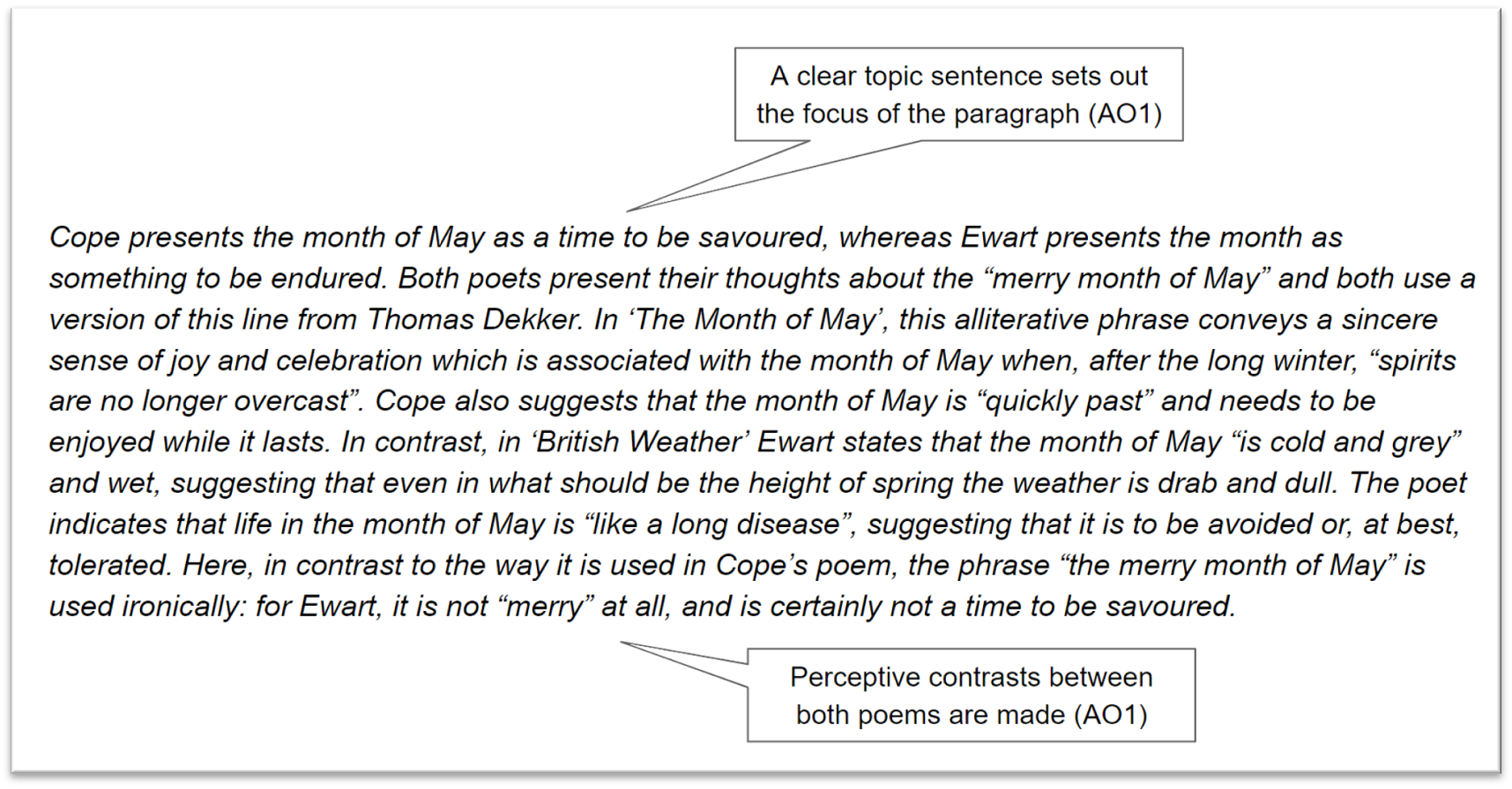|
Both Ewart and Cope have chosen to explore the month of May within their respective poems and offer contrasting perspectives. While Cope paints a vibrant and cheerful image of May, Ewart adopts a more pessimistic stance.
Cope presents the month of May as a time to be savoured, whereas Ewart presents the month as something to be endured. Both poets present their thoughts about the “merry month of May” and both use a version of this line from Thomas Dekker. In ‘The Month of May’, this alliterative phrase conveys a sincere sense of joy and celebration which is associated with the month of May when, after the long winter, “spirits are no longer overcast”. Cope also suggests that the month of May is “quickly past” and needs to be enjoyed while it lasts. In contrast, in ‘British Weather’ Ewart states that the month of May “is cold and grey” and wet, suggesting that even in what should be the height of spring the weather is drab and dull. The poet indicates that life in the month of May is “like a long disease”, suggesting that it is to be avoided or, at best, tolerated. Here, in contrast to the way it is used in Cope’s poem, the phrase “the merry month of May” is used ironically: for Ewart, it is not “merry” at all, and is certainly not a time to be savoured.
In contrast to Ewart’s presentation, Cope describes the month of May as being full of beauty, colour and life. The colour imagery of “I saw a hundred shades of green” and “hello pink and white and farewell grey” suggest that the speaker in Cope’s poem believes that May ushers in a vibrancy that is missing from the “grey” that has come before. While the month of May makes the speaker in Cope’s poem feel happy and optimistic, through phrases such as “spirits are no longer overcast”, “The world is glorious”, Ewart’s speaker suggests that “nothing seems to be much fun” and that even though flowers (normally a symbol of life and happiness) are trying to be “optimistic”, they are “beaten down” by the bad weather. Indeed ‘British Weather’ ends with sarcasm and irony: “this is the marvellous British Spring!” Therefore, although both poets use colour imagery in their poems, Cope does this to highlight the energy and exuberance of May, while Ewart sees everything as “grey”.
While Cope presents her speaker as waiting in eager anticipation of May, Ewart presents the month as boring and seemingly never-ending, In ‘The Month of May’ Cope uses antithesis to emphasise how quickly the month of May seems to pass: “So long awaited, and so quickly past”; “summers come, the summers go”. The phrase “so long awaited” underscores the eager anticipation and perhaps even longing for the arrival of the month. In comparison, Ewart employs.onomatopoeia (“dripping”) to reflect the relentless, yet slow-moving, sound of the rain. This could highlight how interminable the month feels to the speaker. Moreover, similes are used throughout the poem to further enhance this feeling of boredom: “life is like a long disease”, “like ghouls”, and “exciting as a piece of string”.
Both poets use formal structure in their poems to convey their differing perspectives on the month of May. ‘The Month of May’ is a villanelle consisting of 19 lines of five tercets and a quatrain; there are two refrains and two repeated rhymes and “The month of May” is repeated throughout the poem to emphasise the joy that the month brings each year. Parentheses are also used to provide an aside when the poet talks directly to the reader in a relaxed and humorous way: “(Tried to be modern but it didn’t last)”. This reflects the speaker’s joy and sense of ease when thinking about May. In contrast, ‘British Weather’ is written in three quatrains, each one consisting of two pairs of rhyming couplets. The poem is written in one sentence, punctuated with commas and a dash, and this is used to convey the poet’s spontaneous trail of negative thoughts about the month and the weather. This use of one long continuous sentence could also reflect the speaker’s ideas about how the month of May seems incredibly dull and never-ending.
While Cope presents an optimistic and happy view of the month of May, Ewart is more pessimistic: the speaker in ‘The Month of May’ sees May as representing life, colour and joy, while for Ewart’s speaker, the month is something negative to be endured.
|







